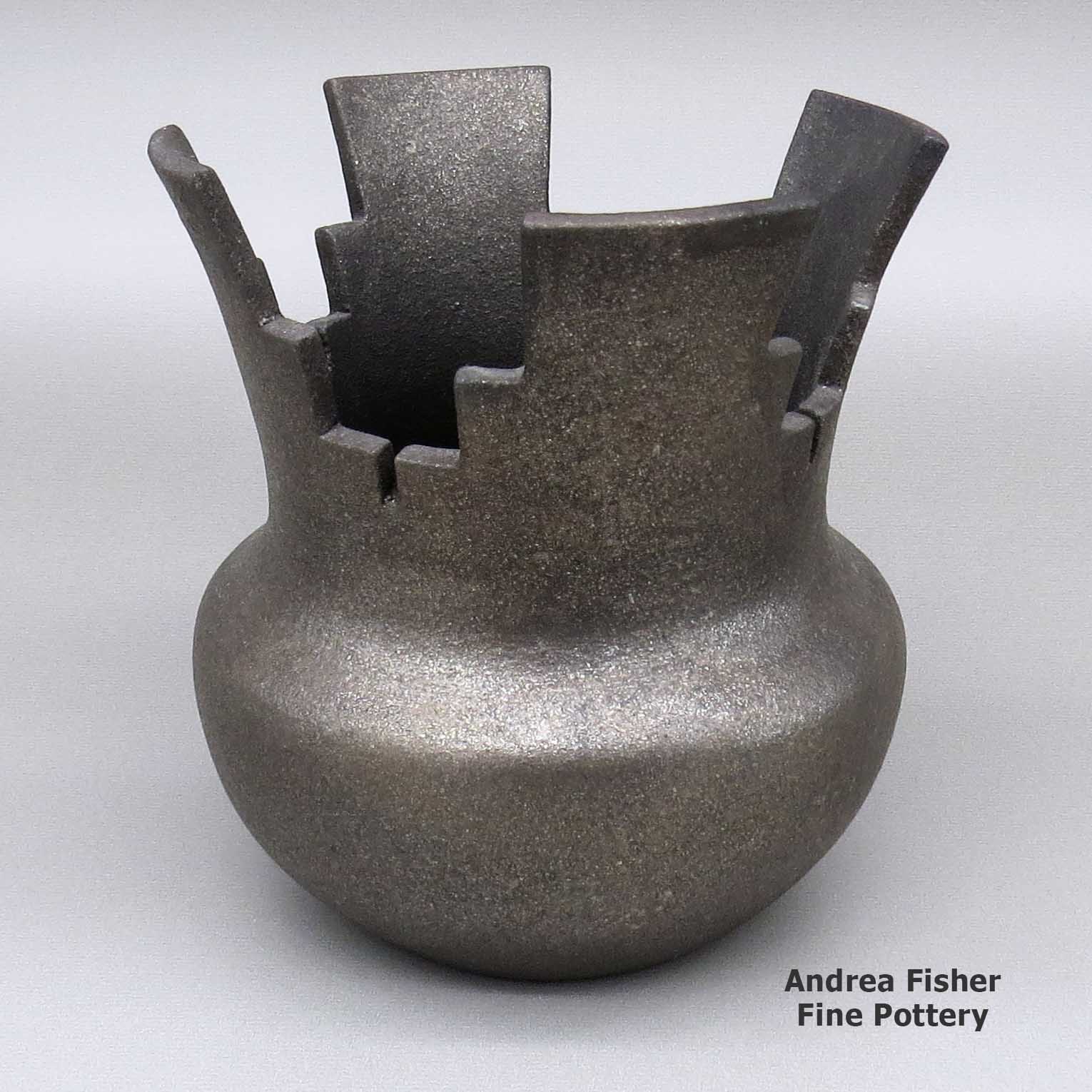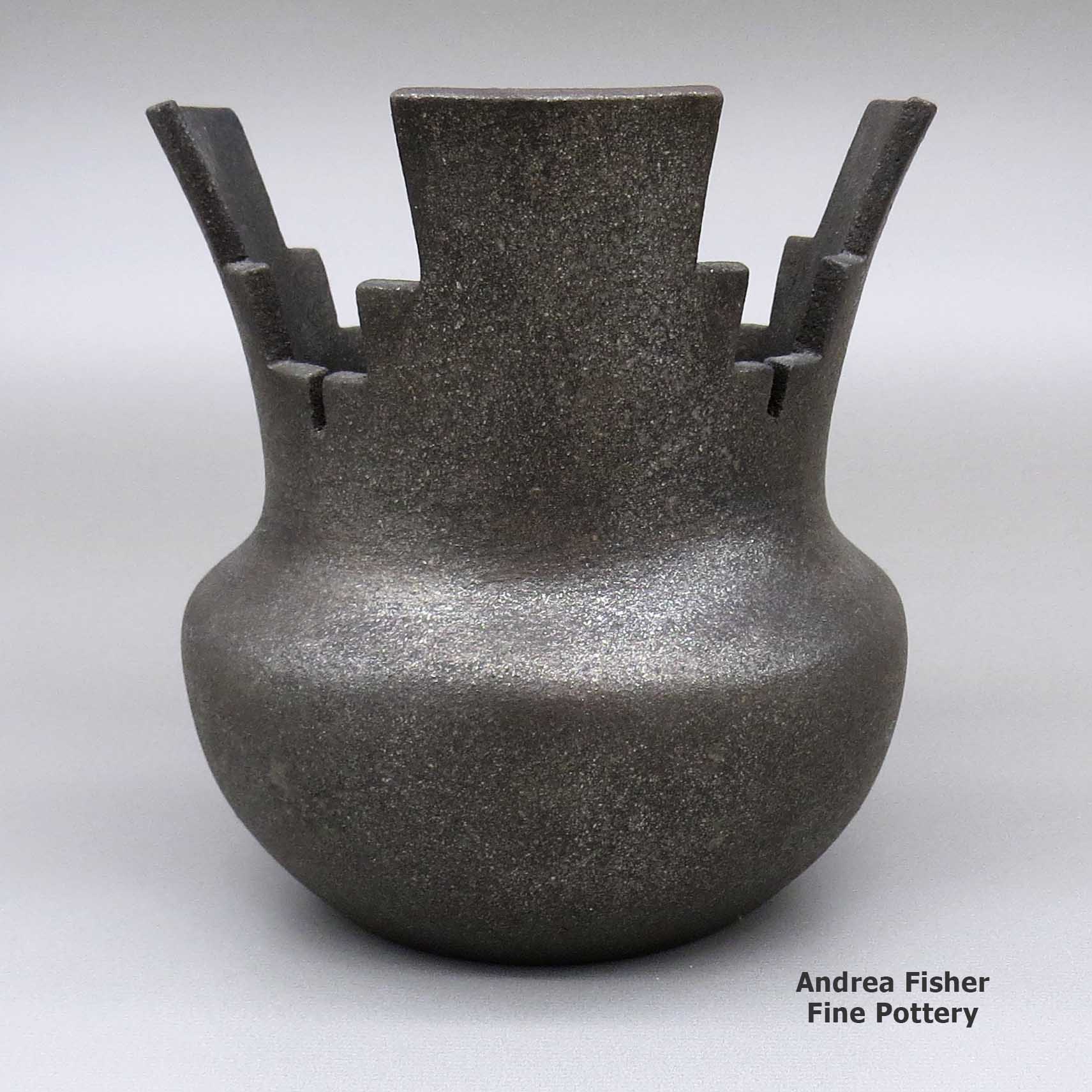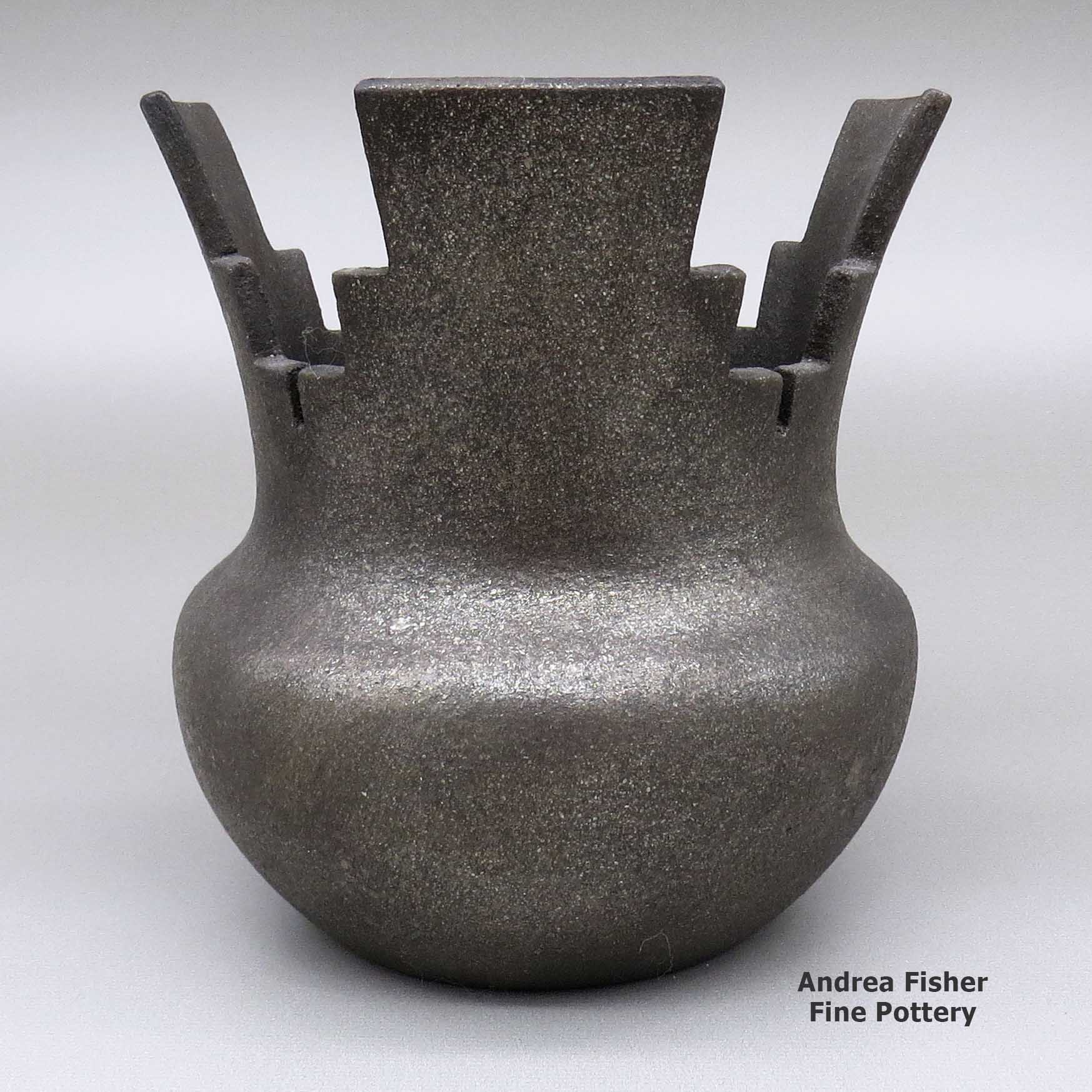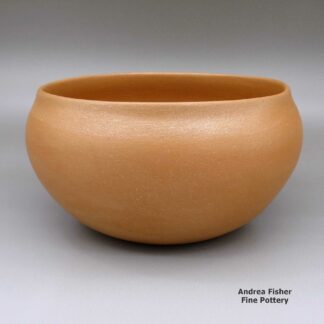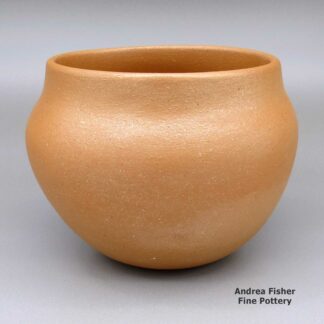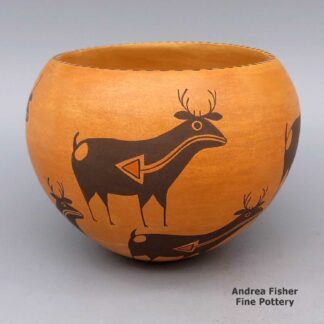| Dimensions | 5.25 × 5.25 × 5.75 in |
|---|---|
| Condition of Piece | Very good |
| Date Born | 2005 |
| Signature | Angie Yazzie Taos Pueblo |
Angie Yazzie, jhta3b162, Micaceous black prayer bowl
$925.00
A micaceous black prayer bowl
In stock
Brand
Yazzie, Angie
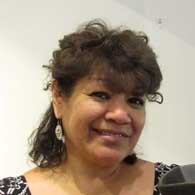 Angie Yazzie was born into Taos Pueblo in 1965. Her parents were Mary A. Archuleta of Taos Pueblo and Nick Yazzie of the Dineh Nation. In keeping with Pueblo tradition Angie was raised at Taos Pueblo.
Angie Yazzie was born into Taos Pueblo in 1965. Her parents were Mary A. Archuleta of Taos Pueblo and Nick Yazzie of the Dineh Nation. In keeping with Pueblo tradition Angie was raised at Taos Pueblo.Angie tells us she began making pottery when she was nine years old. She was introduced to the basics by her mother and her maternal grandmother, Isabel Archuleta.
Angie said she lived with her maternal grandparents for several years as a child. Through them and their shop at the pueblo, she was exposed to the whole range of Pueblo arts and crafts. Clay Mother, though, is who Angie has heard calling her all her life.
After learning the barest basics, Angie struck out on her own and learned to make large golden and black micaceous ollas, like the ollas Taos was famous for making a hundred and more years ago.
Micaceous clay has tiny flecks of mica spread throughout the clay. That mica makes it possible for a micaceous pot to hold liquids for cooking or storing. There are two seams of micaceous clay on the lands of Taos Pueblo and they have been mined for pottery-making material for centuries.
Angie has told us her favorite shape to make is a large, fluted water jar, slipped with micaceous clay. It is exactly that type of jar that has earned her Best of Division and First Place ribbons at the Heard Museum Guild Indian Art Fair & Market, and Best of Division, First, Second and Third Place ribbons at the Santa Fe Indian Market. She's also earned First Place ribbons at the Eight Northern Indian Pueblos Arts & Crafts Show.
Angie says she still gets her inspiration from her fond memories of her maternal grandmother. At the same time, she loves to look at other artists creations and talk to them about how they made it. Angie recently had a piece placed on display at the Winona State College Museum in Winona, Minnesota.
Some of the Awards Angie has earned
- 2020 Heard Museum Guild Indian Fair & Market: Judge's Award - Upton Ethelbah Greyshoes, Jr. Awarded for artwork: "Give Me Water"
- 2018 Santa Fe Indian Market: Classification II - Pottery, Division A - Traditional Unpainted Pottery, Category 502 - Micaceous Ware in the style of Taos, Nambe, Picuris, any form: First Place
- 2018 Heard Museum Guild Indian Fair & Market, Classification II - Pottery, Division B - Unpainted, including ribbed, native clay, hand built, fired out-of-doors: First Place. Awarded for artwork: Black Fluted Vase
- 2018 Heard Museum Guild Indian Fair & Market, Classification II - Pottery, Division G - Pottery miniatures not to exceed three (3) inches at its greatest dimension: Honorable Mention. Awarded for artwork: Rectangle Prayer Plate
- 2017 Santa Fe Indian Market: Classification II - Pottery: Best of Classification
- 2017 Santa Fe Indian Market: Classification II - Pottery, Division A - Traditional Unpainted Pottery: Best of Division
- 2017 Santa Fe Indian Market: Classification II - Pottery, Division A - Traditional Unpainted Pottery, Category 502 - Micaceous Ware in the style of Taos, Nambe, Picuris, any form: First Place
A Short History of Taos Pueblo

Taos Pueblo consists of two main structures, both of which are counted among the oldest continuously inhabited structures in the United States. The location straddles the Rio Pueblo de Taos (also known as Red Willow Creek), whose headwaters rise in the nearby Sangre de Cristo Mountains. The pueblo was designated a National Historic Landmark on October 9, 1960 and was designated a UNESCO World Heritage Site in 1992.
The Taos people first figure in the archaeological record about the same time Pot Creek Pueblo burned and was abandoned in the early 1300s. Some of the residents of Pot Creek split from the others and moved northeast to join with and merge into a small Tanoan pueblo located in a perfect spot with a great view. That became today's Taos Pueblo. The native tongue today at Taos Pueblo is Northern Tiwa, a member of the Tanoan family of languages. It is felt the tribe migrated to the area during the time of the Great Drought in the Four Corners region, the same drought that essentially forced nearly all the Pueblo peoples to migrate to the Rio Grande, Rio Puerco or Little Colorado River areas. The people of Taos, though, also feel that some of their people came from the north, which would include possible Jicarilla Apache migrants, and some from the far south, preferably from Aztec or Mesoamerican lands.
On the other hand, Taos was mostly peopled by 7 Jicarilla Apache clans and 6 Tewa clans, in addition to the one or two Tanoan clans left from before the immigrants arrived. For hundreds of years the semi-nomadic Jicarillas came and went from the forests and mountains around Taos, moving with the seasons. They established settlements in the Tusas Mountains and along the Upper Rio Grande. The economies and families of Taos and the Jicarillas were intertwined. Pottery and other trade goods from the region of Taos Pueblo have been found in Dismal River culture sites in eastern Colorado and across Kansas to the Black Hills of South Dakota. The pueblo served as a central contact point between the Rio Grande Pueblos to the south and the Cheyenne, Arapaho, Comanche, Apache and Ute to the north, northwest and northeast.
Around 1620 a Jesuit priest oversaw the construction of the first mission of San Geronimo de Taos. Friction between the tribe and the Spanish led to the killing of the resident priest and destruction of the church in 1660. Priests returned and rebuilt the church only to have the church destroyed again and two resident priests killed in the beginning hours of the Pueblo Revolt of 1680.
The Spanish were evicted from northern Nuevo Mexico in 1680 but returned in force in 1692. By 1700, a third mission church was being built at Taos Pueblo. For a few years the tribe and the Spanish got along, forced to be amicable in order to deal with their common enemies: the Ute and Comanche tribes. That pressure was relieved in 1776 when Governor Juan Bautista de Anza and his troops killed virtually the entire upper hierarchy of the Comanche tribe in the Battle of Cuerno Verde, near Greenhorn Mountain in southern Colorado.
In the 1700s an annual trade fair was established, promoted by the Spanish. The Spanish also established a slave market on Taos Plaza where captive Native Americans and black slaves were actively sold until Juneteenth Day in 1867. Taos Pueblo became a neutral zone where fighting and raiding were banned for the duration of the fair. The trade fairs continued after Mexico declared its independence in 1820, with a bit more tax and danger added (Mexico couldn't protect anyone from the regularly marauding Comanches, Apaches, Utes and Kiowas).
That's also when American fur trappers and traders first appeared in the area. The American military arrived in 1847, at the beginning of the Mexican-American War. Stephen Watts Kearny and his Army of the West had been waiting at Bents Old Fort on the Arkansas River in Colorado. As soon as the declaration of war happened, they flooded into New Mexico and took the territory without firing a shot. They replaced a few politicians, then they kept going. The American presence quickly led to the Taos Rebellion. The Taos Rebellion saw Governor Charles Bent and several other prominent Americans in the non-Indian village of Taos killed immediately. A few days later American troops and armed citizens arrived from Santa Fe and, thinking the rebels had taken refuge in the San Geronimo de Taos church, they bombarded the church, destroying it and killing many innocent women and children who were hiding inside. That effectively ended the rebellion. After a short trial, 17 of the surviving rebels were hanged from trees surrounding the plaza in the village of Taos.
A new mission church was constructed around 1850 near the west gate of the pueblo wall but the ruins of the old church are still visible today.
One result of the Taos Rebellion is that the tribe has never signed a peace treaty with the United States Government. That led to President Theodore Roosevelt using an Executive Proclamation to remove some 48,000 acres of the pueblo's mountain land and combine that with the fledgling Carson National Forest in 1906. That land was a point of major contention between the pueblo and Congress until it was returned to the tribe by President Richard M. Nixon in 1970. An additional 764 acres was returned to the tribe in 1996.
Today the community of Taos Pueblo is considered one of the most private, secretive and conservative of all the pueblos, even though the Pueblo of Taos offers more shops for visitors than any other pueblo. The North and South Houses of the pueblo are now a UNESCO-designated World Heritage Site.
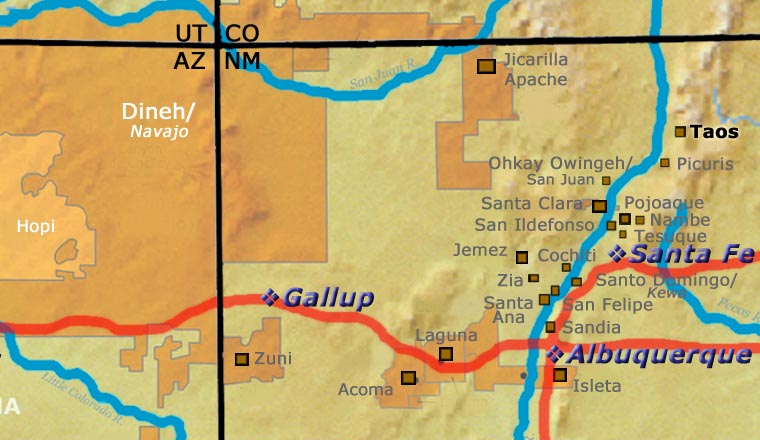
For more info:
Pueblos of the Rio Grande, Daniel Gibson, ISBN-13:978-1-887896-26-9, Rio Nuevo Publishers, 2001
Photo courtesy of Elisa Rolle, Creative Commons Attribution-Share Alike 3.0 Unported License
About Bowls
The bowl is a basic utilitarian shape, a round container more wide than deep with a rim that is easy to pour or sip from without spilling the contents. A jar, on the other hand, tends to be more tall and less wide with a smaller opening. That makes the jar better for cooking or storage than for eating from. Among the Ancestral Puebloans both shapes were among their most common forms of pottery.
Most folks ate their meals as a broth with beans, squash, corn, whatever else might be in season and whatever meat was available. The whole village (or maybe just the family) might cook in common in a large ceramic jar, then serve the people in their individual bowls.
Bowls were such a central part of life back then that the people of the Classic Mimbres society even buried their dead with their individual bowls placed over their faces, with a "kill hole" in the bottom to let the spirit escape. Those bowls were almost always decorated on the interior (mostly black-on-white, color came into use a couple generations before the collapse of their society and abandonment of the area). They were seldom decorated on the exterior.
It has been conjectured that when the great migrations of the 11th, 12th, 13th and 14th centuries were happening, old societal structures had to change and communal feasting grew as a means to meet, greet, mingle with and merge newly arrived immigrants into an already established village. That process called for larger cooking vessels, larger serving vessels and larger eating bowls. It also brought about a convergence of techniques, styles, decorations and design palettes as the people in each locality adapted. Or didn't: the people in the Gallina Highlands were notorious for their refusal to adapt and modernize for several hundred years. They even enforced a No Man's Land between their territory and that of the Great Houses of Chaco Canyon, killing any and all foreign intruders. Eventually, they seem to have merged with the Towa as those people migrated from the Four Corners area to the southern Jemez Mountains.
Traditional bowls lost that societal importance when mass-produced cookware and dishware appeared. But, like most other Native American pottery in the last 150 years, market forces caused them to morph into artwork.
Bowls also have other uses. The Zias and the Santo Domingos are known for their large dough bowls, serving bowls, hair-washing bowls and smaller chili bowls. Historically, these utilitarian bowls have been decorated on their exteriors. More recently, they've been getting decorated on the interior, too.
The bowl has also morphed into other forms, like Marilyn Ray's Friendship Bowls with children, puppies, birds, lizards and turtles playing on and in them. Or Betty Manygoats' bowls encrusted with appliqués of horned toads or Reynaldo Quezada's large, glossy black corrugated bowls with custom ceramic black stands.
When it comes to low-shouldered but wide circumference ceramic pieces (such as many Sikyátki-Revival and Hawikuh-Revival pieces are), are those jars or bowls? Conjecture is that the shape allows two hands to hold the piece securely by the solid body while tipping it up to sip or eat from the narrower opening. That narrower opening, though, is what makes it a jar. The decorations on it indicate that it is more likely a serving vessel than a cooking vessel.
This is where our hindsight gets fuzzy. In the days of Sikyátki, those potters used lignite coal to fire their pieces. That coal made a hotter fire than wood or manure (which wasn't available until the Spanish brought it). That hotter fire required different formulations of temper-to-clay and mineral paints. Those pieces were perhaps more solid and liquid resistant than most modern Hopi pottery is: many Sikyátki pieces survived intact after being slowly buried in the sand and exposed to the desert elements for hundreds of years. Many others were broken but were relatively easy to reassemble as their constituent pieces were found all in one spot and they survived the elements. Today's pottery, made the traditional way, wouldn't survive like that. But that ancient pottery might have been solid enough to be used for cooking purposes, back in the day.
About the Prayer Bowl
The prayer bowl was previously a ceremonial object, to be used only in the kiva during clan gatherings. However, the prayer bowls we see these days were produced primarily for the art market. As such, they are missing some of the designs that would be on display on a prayer bowl made specifically for a kiva ceremony (they are usually broken up after the ceremony concludes, so that they don't somehow escape into the Anglo world).
Among the pueblos that make prayer bowls, generally their prayer bowls have four equally-spaced, two- or three-stepped notches cut into the rim. If there's any other decoration on the piece, it's usually fertility symbols like tadpoles and frogs, and they could be inside and outside the bowl.
